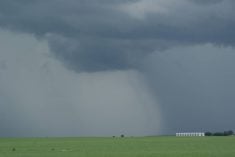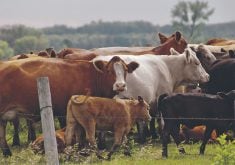“I’m sorry, but it is impossible to grow saskatoons organically,” I recently heard a saskatoon expert tell an audience of potential fruit growers. If she was right, several organic producers are doing the impossible.
Saskatoons grew in abundance across the Prairies before the introduction of agricultural chemicals. They may not be the easiest choice for the organic fruit grower because, being native to the Prairies, they have local pests and diseases.
How can organic producers manage a system that includes a pest-prone species such as saskatoons? In some years, pests can severely limit production. In other years, the pests are limited by weather and by their own pests. When insecticides are used, they can eliminate the beneficial insects that prey on the pests. In organic production, the producer seeks a balance and tries to favour the beneficial insects.
Read Also

Farmer ownership cannot be seen as a guarantee for success
It’s a powerful movement when people band together to form co-ops and credit unions, but member ownership is no guarantee of success.
Diversity is a key principle in organic pest management. Pests are more likely to be a problem when large areas are planted to a single species.
Non-native fruit such as dwarf sour cherries or blue honeysuckles may be easier for organic production on the Prairies. For these plants, there is the possibility of introducing the fruit tree without its native pests.
In a mixed planting, the species that aren’t attractive to a particular pest may reduce that pest’s ability to find its host, similar to hiding the ice cream behind the broccoli.
Having several species reduces the risk of a total crop loss from pests if they do become a problem. It also reduces the risks from weather if the different fruit trees have different flowering and fruiting times.
Different fruits can spread the workload. Maintaining a variety of fruit and non-fruit species can further benefit the orchard by increasing the number of beneficial insects and by reducing the vigour of pest species. For instance, small flowered weeds in shelterbelts can harbour parasitic wasps that reduce caterpillar numbers. Alfalfa in alleyways can reduce the number of grasshoppers in future generations.
On the Prairies we usually benefit from cold winters, dry summers and lots of distance between orchards. The weather reduces our list of potential diseases and pests and the distance makes it less likely that problems will spread among orchards. These factors give us an advantage over Canada’s major fruit growing areas.
Saskatoons are not the first crop organic farmers have been told they could not grow. Organic farmers are seeking damages from Monsanto and Bayer for genetic contamination that resulted in the loss of canola as an organic crop.
Expert witnesses for the chemical companies testified that organic farmers did not have the agronomic tools and skills needed to grow canola successfully. Nevertheless, many organic farmers had grown canola before widespread GM contamination of the crop and they had deemed it a success.
Like saskatoons, canola was a crop with challenges, including a number of potential pests. But through a systems approach and a diversity of techniques, organic producers were able to do what conventional thinkers thought was impossible.
Some conventional farmers consider organic production to be impossible. The most frequent concern is that weed problems would overwhelm them without herbicides. However, organic farmers are finding that the problems don’t make organic production impossible.
Organic production requires a shift in focus. When the focus is on the tools that are no longer available, going organic can seem an intimidating process. Redirecting focus to a long-term systems approach to healthy food production can bring the impossible into reality.
Frick is the Prairie co-ordinator for the Organic Agriculture Centre of Canada located at the University of Saskatchewan. Frick can be reached at 306-966-4975, at brenda.frick@usask.ca, or www.organicagcentre.ca.The opinions expressed in this column are not necessarily those of The Western Producer.














